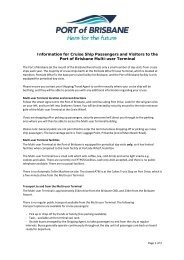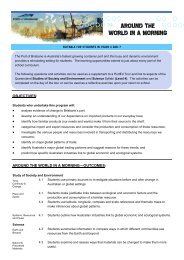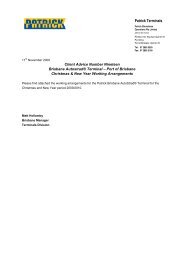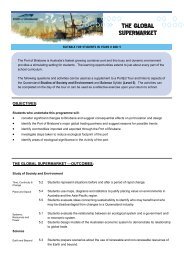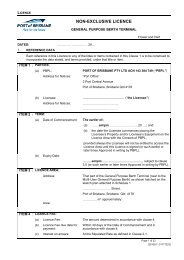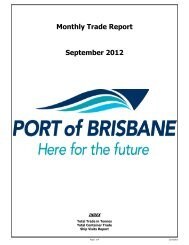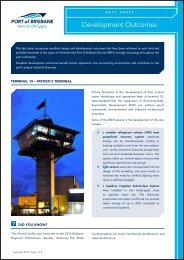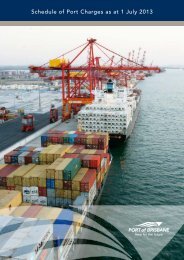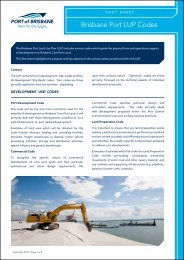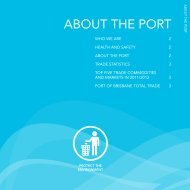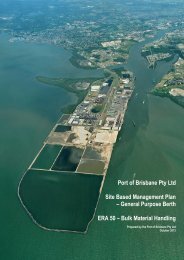WHERE DOES MY “STUFF” COME FROM?
WHERE DOES MY âSTUFFâ COME FROM? - Port of Brisbane
WHERE DOES MY âSTUFFâ COME FROM? - Port of Brisbane
- No tags were found...
You also want an ePaper? Increase the reach of your titles
YUMPU automatically turns print PDFs into web optimized ePapers that Google loves.
<strong>WHERE</strong> <strong>DOES</strong> <strong>MY</strong><br />
<strong>“STUFF”</strong> <strong>COME</strong> <strong>FROM</strong>?<br />
SUITABLE FOR STUDENTS IN YEARS 4 AND 5<br />
The Port of Brisbane is Australia’s fastest growing container port and this busy and dynamic environment<br />
provides a stimulating setting for students. The learning opportunities extend to just about every part of the<br />
school curriculum.<br />
The following questions and activities can be used as a supplement to a PortEd Tour and link to aspects of<br />
the Queensland Studies of Society and Environment and Science Syllabi (Level 3). The activities can<br />
be completed on the day of the tour or can be used as a reflective exercise upon your return to school.<br />
OBJECTIVES:<br />
Students who undertake this program will:<br />
• consider significant changes to Brisbane and suggest consequential effects on port location and design;<br />
• identify Australia’s major global trading partners on a world map and suggest reasons for possible trends;<br />
• develop an understanding of our dependence on imported products in our everyday lives;<br />
• observe Queensland resources being exported around the world;<br />
• identify how familiar products (our needs and wants) make it from their source to the shelf; and<br />
• investigate the various people and resources involved in transporting and distributing the resources we<br />
consume.<br />
<strong>WHERE</strong> <strong>DOES</strong> <strong>MY</strong> <strong>“STUFF”</strong> <strong>COME</strong> <strong>FROM</strong>? —OUT<strong>COME</strong>S:<br />
Study of Society and Environment<br />
Time,<br />
Continuity &<br />
Change<br />
3.2 Students create sequences and timelines about specific Australian changes and<br />
continuities.<br />
3.4 Students organise information about the causes and effects of specific historical events.<br />
Place and<br />
Space<br />
3.4 Students use and make maps to identify coastal and land features, countries and<br />
continents, and climate zones.<br />
Systems,<br />
Resources<br />
and Power<br />
Science<br />
Earth and<br />
Beyond<br />
2.1 Students investigate the origins and processing of a familiar product to describe relevant<br />
conservation strategies.<br />
2.2 Students create a representation of various people and resources involved in the<br />
production and consumption of familiar goods and services.<br />
3.3 Students collect information that describe ways in which living things use the Earth and<br />
sun as resources.
<strong>WHERE</strong> <strong>DOES</strong> <strong>MY</strong><br />
<strong>“STUFF”</strong> <strong>COME</strong> <strong>FROM</strong>?<br />
NAME: _________________________ DATE: ____/____/_______<br />
Have you ever wondered exactly where your stuff comes from? I mean,<br />
before it arrives in the shop for you to buy? PB is here to tell you the<br />
story behind some familiar products.<br />
People’s needs and wants have changed over-time. As a result, Brisbane’s seaport<br />
has gone through many changes too.<br />
IMAGE ONE: In the mid to late 1800s, port activities occurred in the City Reach of the Brisbane River between Kangaroo Point and Victoria<br />
Bridge—now South Bank.<br />
ACTIVITY: Choose the word that completes the following sentences to explain the<br />
differences between this historical image and what you saw on your tour of the Port of<br />
Brisbane.<br />
• Brisbane’s port has moved to the FOOT / MOUTH of the Brisbane River.<br />
• The railway lines DO / DO NOT run right beside the ships.<br />
• The ships are BIGGER / SMALLER.<br />
• PEOPLE / MACHINERY is now used to load and unload ships.
<strong>WHERE</strong> <strong>DOES</strong> <strong>MY</strong><br />
<strong>“STUFF”</strong> <strong>COME</strong> <strong>FROM</strong>?<br />
Each of the things we buy has a story attached to it, which tells of the journey it has travelled<br />
before arriving on the store shelf.<br />
ACTIVITY: Listen to the story ‘Around the World in a Morning’. Colour the dots<br />
on the map as you hear a country or city mentioned. At the end of the story you<br />
will see how aspects of your daily life connect you to the global community.<br />
ARCTIC OCEAN<br />
Germany<br />
Saudi Arabia<br />
India<br />
South Korea<br />
Japan<br />
Taiwan<br />
Philippines<br />
Thailand<br />
PACIFIC OCEAN<br />
United States<br />
of America<br />
NORTH<br />
ATLANTIC<br />
OCEAN<br />
Indonesia<br />
SOUTH<br />
ATLANTIC<br />
OCEAN<br />
INDIAN OCEAN<br />
Australia<br />
SOUTHERN OCEAN<br />
ACTIVITY: Tick the items that you have at home.<br />
Many of these goods are not made in Australia, therefore they have to be imported from<br />
another country.
<strong>WHERE</strong> <strong>DOES</strong> <strong>MY</strong><br />
<strong>“STUFF”</strong> <strong>COME</strong> <strong>FROM</strong>?<br />
In order for us to have the goods that we want and need, it takes many people<br />
and a range of resources to transport these products to our local store.<br />
ACTIVITY: Sugar is a product we buy from the shop to use<br />
on our cereal or in our baking. Below is a list of people who<br />
help this product to reach the shelves in our local shop.<br />
Draw a line matching the jobs to their description.<br />
Plants, grows and harvests sugar cane.<br />
MILL WORKER<br />
Transports sugar cane to the sugar mill.<br />
SHIP MASTER<br />
Makes raw sugar out of the sugar cane.<br />
FARMER<br />
Drives the ship that takes sugar to other countries.<br />
STORE SHELF<br />
STACKER<br />
Stacks the shelves with sugar bags at the shops.<br />
TRAIN DRIVER
<strong>WHERE</strong> <strong>DOES</strong> <strong>MY</strong><br />
<strong>“STUFF”</strong> <strong>COME</strong> <strong>FROM</strong>?<br />
During your tour of the Port of Brisbane, you saw a number of resources that are used by<br />
humans—both natural and manufactured.<br />
ACTIVITY: Match statements A—D with the correct resources pictured below.<br />
A. This natural resource is exported to Japan where they use it to make newspaper.<br />
B. This natural resource is exported to Japan and Korea where they use it to<br />
generate electricity.<br />
C. This natural resource is imported to Australia from Papua New Guinea, Indonesia<br />
and Saudi Arabia to make petrol for vehicles.<br />
D. This manufactured good contains natural resources mined in Adelaide and<br />
Gladstone. We use this resource to bind bricks together in buildings.<br />
CRUDE OIL<br />
COAL<br />
CEMENT<br />
WOODCHIP<br />
A port is a place where ships come to load and unload goods.<br />
Imports are goods that are coming into Australia.<br />
Exports are goods that are going out of Australia.<br />
Resources: Something we use to satisfy our needs.<br />
Natural Resources: The parts of natural systems such as soil, trees,<br />
water and minerals that we use to satisfy our needs.<br />
Manufactured Goods: Goods that are made (not found in nature).




